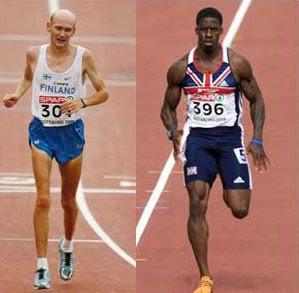THEY DIFFER IN SEVERAL WAYS
Fast twitch muscle fibers:
- Contract rapidly and generate a lot of force in a short amount of time
- Fatigue quickly, which makes them suitable for short bursts of intense activity
- Primarily rely on anaerobic metabolism, which does not require oxygen
- Are used for explosive, high intensity activity, such as sprinting, weight lifting and jumping
Slow twitch muscle fibers:
- Contract slowly and generate less force per contraction than fast twitch fibers
- Have a high resistance to fatigue and are suitable for endurance activities
- Rely on aerobic metabolism, which requires oxygen and is efficient for long-duration activities
- Are used for activities such as long distance running, cycling and swimming

Research on sports performance within families shows us that there is a wide range of genetic factors that may contribute to muscle fiber type differences in individuals. But fiber type is not the best predictor of athletic success. Other factors include nutrition, hydration, equipment, conditioning and rest.
On average, people have about 50% fast twitch and 50% slow twitch muscle fibers. Muscles that move our eyes are made up of fast twitch fibers. Chest, arm and hamstring muscles are fast twitch, while the muscles of our back (which support posture) and the soleus muscle in our lower legs are both slow twitch.
Over time, we can shift types to the sport we are playing with consistent training.
WORKOUT MODES
Strength training:
- Fast twitch – weight lifting develops fast twitch muscle fibers, since high workloads and explosive activity are done
- Slow twitch – these fibers can be involved with slower, controlled or isometric movements
Cardiovascular exercise:
- Fast twitch – fibers are involved with HIIT (high intensity interval training) workouts
- Slow twitch – fibers are used in the traditional cardio exercises, such as running, cycling and swimming
In the picture below, the distance runner is on the left, the sprinter on the right

There are some sports activities that involve both fast and slow twitch muscle fibers in varying degrees. Circuit training, CrossFit, basketball and soccer are examples. These sports combine elements of strength, speed and endurance. A balanced development of both types of muscle fibers is required.
TRAINING EQUIPMENT
Below are several choices of equipment for training either or both types of our muscles fibers. Amazon is the source. As an Amazon associate, I am able to use their links within my posts and benefit from activity on the links. This has no effect on pricing, except that today is the final day of the Amazon Prime “big deal” event for Prime members.


Resistance bands – in my opinion, the best bargain for home workouts

Nordic Track treadmill – I use this model at home and find it very durable with daily use



FINAL THOUGHTS
I always include two permanent links at the side of my website. These are updated with current information every day. Both are able to offer many options for muscle development, fast and slow twitch:
- Dick’s Sporting Goods – click on the red link
- Bullworker fitness – click on the red link
A well-rounded overall fitness program will generally include a mix of both strength and cardiovascular training to target both fast twitch and slow twitch muscle fibers. This is the best way to promote overall muscle health and functional capacity.
Please leave me any comments or questions in the “Comments” section below. Or email me, richard@myworkoutathome.com.
Be well and let’s keep working out!